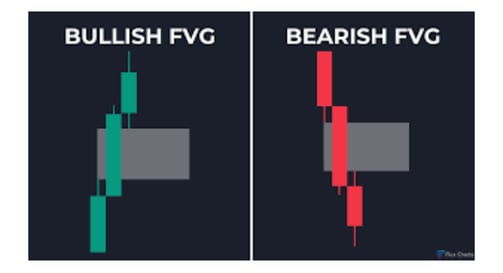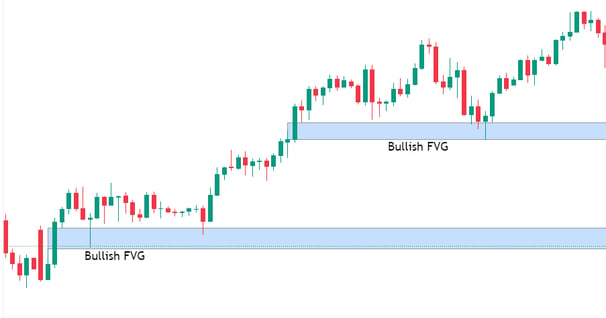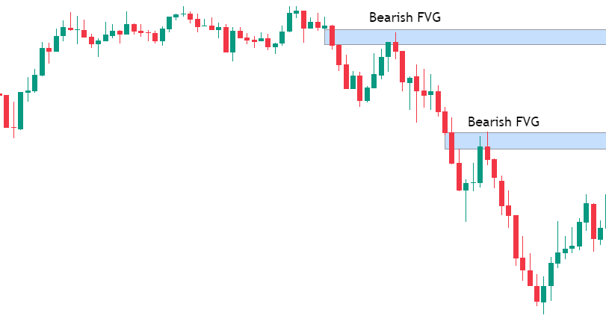ICT Fair Value Gap (FVG)
Satheesh V
3/3/20256 min read
ICT Fair Value Gap (FVG) Explained
Master the ICT Fair Value Gap Trading Strategy Like a Pro
Do you want to enhance your trading skills and learn how to trade ICT fair value gaps like a professional trader? If so, this guide will help you understand ICT fair value gaps from both a theoretical and practical perspective. We will cover their definition, formation, and how to trade them effectively across various financial markets such as forex, indices, metals, stocks, crypto, and commodities.
What is ICT Fair Value Gap (FVG)?
Theoretical Explanation of ICT Fair Value Gap
A fair value gap (FVG) is a price inefficiency or imbalance that occurs when the market fails to trade through a particular price level due to excessive buying or selling pressure. The gap represents an area where price did not fully balance between buyers and sellers, and it often acts as a magnet for price correction.
For example, suppose you and other traders believe that the fair price of XAU/USD (Gold) should be $2950, but the market is currently trading at $2940. This suggests the asset is undervalued by $10, creating a fair value gap of $10. Likewise, if an asset is overvalued, traders expect it to return to its fair value.
Many factors can cause fair value gaps, such as institutional manipulations, market news, liquidity voids, or high volatility. Smart money traders often use these gaps as trading opportunities to buy undervalued assets or sell overvalued assets based on technical confirmations.
Other Common Terms for Fair Value Gaps:
FVG
Price Imbalance
Market Inefficiency
Based upon the trend we can categorize fair value gap into two types.
ICT Bullish Fair Value Gap
ICT Bearish Fair Value Gap
What is an ICT Bullish Fair Value Gap?
A bullish fair value gap is a price inefficiency that occurs during an uptrend. In technical terms, it appears in a three-candle formation:
The Middle Candle: A large-bodied bullish candle that represents an impulsive move upward.
The Formation: The gap is defined by the high of the first (preceding) candle and the low of the third (following) candle. This gap represents an area where the market did not trade efficiently.
In a bullish trend, this gap tends to be filled by price retracements acting as support. The smart money often anticipates that price will eventually return to these levels before resuming its upward movement.
Formation and Characteristics
Three-Candle Structure:
First Candle: Typically smaller in size; its high sets the upper boundary.
Middle Candle: A large bullish candle with minimal wicks, signaling strong buying pressure.
Third Candle: A smaller candle that fails to completely overlap the body of the middle candle, leaving a gap.
Gap Identification:
The bullish FVG is identified by the gap between the high of the first candle and the low of the third candle.
This gap signifies an area where there was not enough liquidity or order flow, which price later revisits.
Market Behavior:
In an uptrend, this gap usually acts as a support zone. When price retraces, buyers often step in, filling the gap and setting the stage for further upward momentum.
What is an ICT Bearish Fair Value Gap?
A bearish fair value gap is a price imbalance that occurs during a downtrend. It also appears in a three-candle formation, but with a slight variation:
The Middle Candle: A large-bodied bearish candle indicating strong selling pressure.
The Formation: The gap is defined by the low of the first (preceding) candle and the high of the third (following) candle. This gap highlights an area where the market did not completely fill the order book during the move downward.
In a bearish trend, this gap tends to act as a resistance level. When price retraces upward, it often encounters resistance at this gap, offering a potential opportunity for short trades.
Formation and Characteristics
Three-Candle Structure:
First Candle: Typically a smaller candle whose low sets the lower boundary.
Middle Candle: A large bearish candle with minimal wicks, signifying a forceful downward move.
Third Candle: A smaller candle that does not completely overlap the body of the middle candle, creating a gap.
Gap Identification:
The bearish FVG is identified by the gap between the low of the first candle and the high of the third candle.
This gap represents an area where selling pressure was so strong that it left behind a liquidity void.
Market Behavior:
In a downtrend, the FVG acts as a resistance area. When price retraces upward, sellers typically re-enter, filling the gap and reinforcing the downtrend.


How to trade a Bullish Fair Value Gap?
Step 1: Identify a Bullish Market Trend
Look for higher highs and higher lows to confirm an uptrend.
Use tools like moving averages or ICT Daily Bias Trick to confirm bullish sentiment.
Step 2: Locate a Large Bullish Candle (Impulse Move)
Find a strong bullish candle with a large body and small wicks.
The bullish candle should have a clear price imbalance between its high and the low of the following candle.
Step 3: Analyze the Preceding and Following Candles
The first candle’s high should not overlap the third candle’s low, confirming a fair value gap.
Step 4: Mark the Bullish Fair Value Gap
The FVG is found between the high of the first candle and the low of the third candle.
Step 5: Enter a Buy Trade
Wait for price to retrace and test the FVG.
Look for bullish confirmation signals such as rejection wicks, bullish engulfing candles, or market structure shifts.
Place a stop loss below the FVG.
Set a take profit at the next resistance level or previous swing high.


How to trade a Bearish Fair Value Gap?
Step 1: Identify a Bearish Market Trend
Look for lower highs and lower lows to confirm a downtrend.
Use tools like moving averages or ICT Daily Bias Trick to confirm bearish sentiment.
Step 2: Locate a Large Bearish Candle (Impulse Move)
Find a strong bearish candle with a large body and small wicks.
The bearish candle should have a clear price imbalance between its low and the high of the following candle.
Step 3: Analyze the Preceding and Following Candles
The first candle’s low should not overlap the third candle’s high, confirming a fair value gap.
Step 4: Mark the Bearish Fair Value Gap
The FVG is found between the low of the first candle and the high of the third candle.
Step 5: Enter a Sell Trade
Wait for price to retrace and test the FVG.
Look for bearish confirmation signals such as rejection wicks, bearish engulfing candles, or market structure shifts.
Place a stop loss above the FVG.
Set a take profit at the next support level or previous swing low.


Using Fair Value Gaps in Conjunction with Other Strategies
While ICT fair value gaps are powerful, they work best when combined with other trading strategies:
1. Support and Resistance Zones
If an FVG aligns with a major support or resistance level, it becomes a high-probability trading zone.
2. Supply and Demand Zones
FVGs often coincide with institutional supply and demand zones, providing further validation.
3. Liquidity Zones & Smart Money Concepts
Large institutions use fair value gaps to execute orders in areas of liquidity grabs before price moves in the intended direction.
Common Mistakes to Avoid When Trading Fair Value Gaps
Ignoring Market Context
Not every fair value gap is tradeable; always consider trend, liquidity, and market structure.
Overtrading Fair Value Gaps
Not every imbalance must be filled; focus on high-probability setups.
Neglecting Stop Losses
Always use stop-loss orders to protect capital from unexpected market movements.
Trading Without Confirmation
Entering a trade blindly on an FVG without candlestick rejections or structure shifts can lead to losses.
Final Thoughts
ICT Fair Value Gap trading is a powerful strategy that helps traders identify price inefficiencies and take trades at optimal levels. However, it should not be used in isolation. The best traders combine fair value gaps with trend analysis, supply & demand zones, and liquidity concepts to refine their entries.
By mastering FVGs, you can develop a solid strategy that enhances your trading performance across forex, commodities, indices, crypto, and stocks.
Always remember: No strategy is foolproof. Use proper risk management, stop losses, and confirmations to make the most out of ICT fair value gaps in your trading journey.
Happy Trading!


